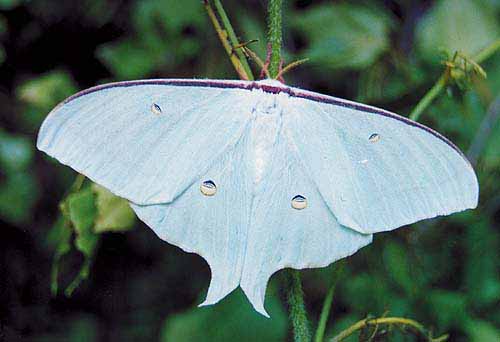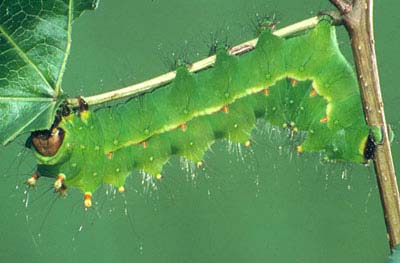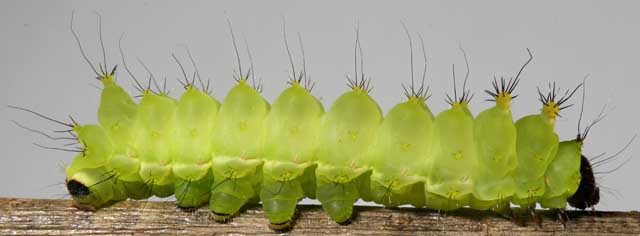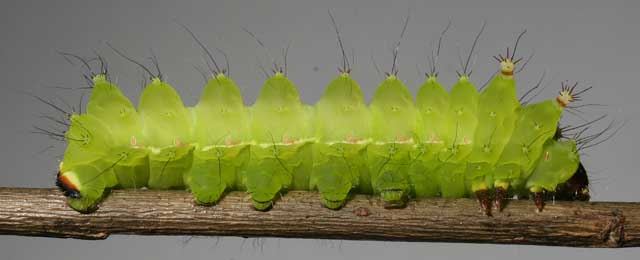Actias artemis
Actias artemis
AKT-ee-uhsmmAR-teh-muhs
(Bremer and Grey, 1864)

Actias artemis (male) from Leroy Simon
This site has been created by
Bill Oehlke at oehlkew@islandtelecom.com
Comments, suggestions and/or additional information are welcomed by Bill.
TAXONOMY:Superfamily Bombycoidea, Latreille, 1802
Family: Saturniidae, Boisduval, [1837] 1834
Subfamily: Saturniinae, Boisduval, [1837] 1834
Tribe: Saturniini, Boisduval, [1837] 1834
Genus: Actias, Leach, 1815
| |
MIDI MUSIC
"Moon River"
copyright C. Odenkirk
MIDI CITYON.OFF
<bgsound src="moon.mid" LOOP=FOREVER>
|
DISTRIBUTION:
Actias artemis, the Japanese Moon
Moth, (forewing length: males: 28.65mm; females: 30.5mm)
is found in Japan, Korea, northeastern China (Heilongjiang, Jilin
and other northeastern provinces) and
other parts of Asia, including the Russian Far East and Primorye.
Specimens from Siberia are probably Actias sjoeqvisti.
Visit Actias artemis male, female and instars 3, 4 and 5, Japan,
courtesy of Leroy Simon.
FLIGHT TIMES AND PREFERRED FOOD PLANTS:
The preferred foodplant is walnut, but Actias artemis also accepts cherry,
oak, beech, and hickory.
Larry Silenius has had success rearing them on black walnut (Juglans nigra).
Moths are on the wing in May and June with a partial second brood in August if the weather has been warm.
early, warm springs result in a double brood.
ECLOSION, SCENTING AND MATING:
This species has shorter tails than the other Actias members. The tails
are especially truncated in the females (to the right) and turn out straight to the sides when wings are open and spread.
Males use quadripectinate antennae to locate scenting females at night. Mating occurs after 10:30 pm and the pair remain coupled until the
following evening. Others report pairings are sometimes brief, lasting only a couple of hours.
| 
|

Actias artemis female.
See beautiful pictures of a male and an inflating female from Vladivostok, in eastern Russia, at
Actias artemis Vladivostok, Russia.
EGGS, LARVAE, COCOONS AND PUPAE:
Eggs are medium-sized round, flattened spheres.
Basis colouration is white, but black/brown mottling is extensive. Misting
of eggs is recommended, but they should not lie in water. A damp piece of crumple paper towelling can also be used to provide high humidity.
Larvae are pale green and almost identical to Actias selene, although a little smaller than
selene. Larvae do well on cut food, provided it is fresh. Cherry
stems keep extremely well if cut ends are kept wet (submerged or wrapped in moist towelling).
Photo courtesy of Leroy Simon.
This species also does well on cut food in sealed containers. They like it warm. |
 |
Cocoons are brown and papery and usually wrapped in a leaf which
falls to the ground with leaf drop in the fall.


Actias artemis first instar, courtesy of
Franz and Julian Renner

Actias artemis third instar, courtesy of
Franz and Julian Renner

Actias artemis fourth instar, courtesy of
Franz and Julian Renner
Larval Food Plants
It is hoped that this alphabetical listing followed by the common name of the foodplant will
prove useful. The list is not exhaustive. Experimenting with closely
related foodplants is worthwhile.
Acer
Alnus firma
Betula platyphylla
Carya
Castanea mollissima
Fagus crenata
Ilex verticillata
Juglans nigra (LS)
Juglans regia
Prunus armeniaca
Prunus virginiana
Prunus pseudo-cerasus.....
Punica
Pyrus malus
Pyrus communis
Quercus
Rosa
Salix
|
Maple
Alder
Japanese white birch
Hickory
Chinese chestnut
Japanese beech
Black alder
Black Walnut
English walnut
Domestic plum
Chokecherry
Cherry
Pomegranate
Apple
Pear
Oak
Rose
Willow
|
Use your browser "Back" button to return to the previous page.
Goto Asian Pacific Saturniidae Directory
Goto Main Saturniidae Index







